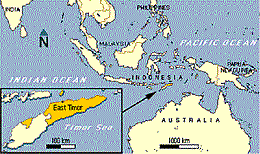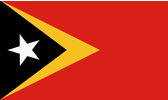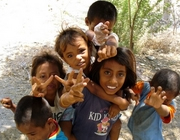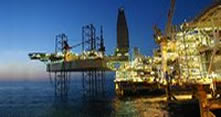Country Profile
Geography
Located in Southeast Asia, the island of Timor is part of the Maritime Southeast Asia, a nd is the largest and easternmost of the Lesser Sunda Islands. To the north of the mountainous island are the Ombai Strait, Wetar Strait and the greater Banda Sea, to the south the Timor Sea separates the island from Australia, while to the west lies the Indonesian Province of East Nusa Tenggara. The highest mountain of East Timor is Tatamailau (also known as Mount Ramelau) at 2,963 meters (9,721 feet). The local climate is tropical and generally hot and humid, characterized by distinct rainy and dry seasons. The capital, largest city and main port is Dili, and the second-largest city is the eastern town of Baucau. The easternmost area of Timor-Leste consists of the Paitchau Range and Iralalaro area. This area has been proposed as the first conservation area in Timor-Leste as it contains the last remaining tropical dry forested area within the country. It hosts a number of unique plant and animal species and is sparsely populated. The northern coast is characterized by a number of coral reef systems that have been determined to be at risk.
nd is the largest and easternmost of the Lesser Sunda Islands. To the north of the mountainous island are the Ombai Strait, Wetar Strait and the greater Banda Sea, to the south the Timor Sea separates the island from Australia, while to the west lies the Indonesian Province of East Nusa Tenggara. The highest mountain of East Timor is Tatamailau (also known as Mount Ramelau) at 2,963 meters (9,721 feet). The local climate is tropical and generally hot and humid, characterized by distinct rainy and dry seasons. The capital, largest city and main port is Dili, and the second-largest city is the eastern town of Baucau. The easternmost area of Timor-Leste consists of the Paitchau Range and Iralalaro area. This area has been proposed as the first conservation area in Timor-Leste as it contains the last remaining tropical dry forested area within the country. It hosts a number of unique plant and animal species and is sparsely populated. The northern coast is characterized by a number of coral reef systems that have been determined to be at risk.
A Brief History
Timor Island was first colonized by the Portuguese in 1515. The Dutch, who claimed many of the surrounding islands, took control of the western portion of the island in 1613. Portugal and the Netherlands fought over the island until an 1859 treaty divided Timor, granting Portugal the eastern half of the island as well as the enclave of Oecussi (the first Portuguese settlement on the island). Australia and Japan fought each other on the island during World War II where nearly 60,000 East Timorese died during the subsequent Japanese occupation.
In 1949, the Netherlands gave up its colonies in the Dutch East Indies, including West Timor, and the nation of Indonesia was born. Timor-Leste remained under Portuguese control until 1975, when the Portuguese abruptly pulled out after 460 years of colonization following the change of government in Portugal in the wake of the Carnation Revolution. The sudden Portuguese withdrawal left the island vulnerable. On November 28, 1975, the East Timorese FRETILIN party unilaterally declared independence from Portugal. The Democratic Republic of Timor-Leste (RDTL) was born. On December 7, 1975. Nine days later, it was invaded and occupied by Indonesian forces before the declaration could be internationally recognized. The territory was declared the 27th province of Indonesia in July 1976 despite the UN Security Council's unanimous vote for Indonesia to stop its invasion and to withdraw immediately from Timor-Leste's borders. Its nominal status in the UN remained that of a "non-self-governing territory under Portuguese administration. Over 250,000 people, one third of the population of 1975, lost their lives in conflict-related deaths in the period between 1974-1999. Following a UN-sponsored agreement between Indonesia, Portugal and the United States and a surprise decision by the Indonesian President B. J. Habibie, a UN-supervised popular referendum was held on August 30, 1999 to choose between Special Autonomy within Indonesia and independence. A 78.5% of voters chose independence, which resulted in violent clashes, instigated primarily by elements within the Indonesian military and aided by Timorese pro-Indonesia militia. Shortly after, a punitive scorched-earth campaign commenced. The militias killed approximately 1,400 Timorese and forcibly pushed 300,000 people into West Timor as refugees, and destroyed 85% of the country's infrastructure. On 20 September 1999, an International Force for East Timor (INTERFET), led by Australia, was deployed to the country and brought the violence to an end. Following a United Nations-Administered Transition (UNTAET) period. On May 20, 2002, the independence of Timor-Leste was restored and power was handed from the United Nations to the first Constitutional Government of the Democratic Republic of Timor-Leste.
years of colonization following the change of government in Portugal in the wake of the Carnation Revolution. The sudden Portuguese withdrawal left the island vulnerable. On November 28, 1975, the East Timorese FRETILIN party unilaterally declared independence from Portugal. The Democratic Republic of Timor-Leste (RDTL) was born. On December 7, 1975. Nine days later, it was invaded and occupied by Indonesian forces before the declaration could be internationally recognized. The territory was declared the 27th province of Indonesia in July 1976 despite the UN Security Council's unanimous vote for Indonesia to stop its invasion and to withdraw immediately from Timor-Leste's borders. Its nominal status in the UN remained that of a "non-self-governing territory under Portuguese administration. Over 250,000 people, one third of the population of 1975, lost their lives in conflict-related deaths in the period between 1974-1999. Following a UN-sponsored agreement between Indonesia, Portugal and the United States and a surprise decision by the Indonesian President B. J. Habibie, a UN-supervised popular referendum was held on August 30, 1999 to choose between Special Autonomy within Indonesia and independence. A 78.5% of voters chose independence, which resulted in violent clashes, instigated primarily by elements within the Indonesian military and aided by Timorese pro-Indonesia militia. Shortly after, a punitive scorched-earth campaign commenced. The militias killed approximately 1,400 Timorese and forcibly pushed 300,000 people into West Timor as refugees, and destroyed 85% of the country's infrastructure. On 20 September 1999, an International Force for East Timor (INTERFET), led by Australia, was deployed to the country and brought the violence to an end. Following a United Nations-Administered Transition (UNTAET) period. On May 20, 2002, the independence of Timor-Leste was restored and power was handed from the United Nations to the first Constitutional Government of the Democratic Republic of Timor-Leste.
People
The people of Timor-Leste belong to Melanesian or Malay-Polynesian group. Their ancestors traced back to China and the Arab world. The population of Timor-Leste is among the fastest and the highest  growth in the world. The current population growth is 3.00 % per year.The average family size is 7 children per family. The rapid population growth will have tremendous impact on the economy. Each year an estimated 14,000 young people enter the labor force increases swollen up employment rate in the country.
growth in the world. The current population growth is 3.00 % per year.The average family size is 7 children per family. The rapid population growth will have tremendous impact on the economy. Each year an estimated 14,000 young people enter the labor force increases swollen up employment rate in the country.
Languages: Tetum, Portuguese (official); Bahasa Indonesia, English
Indigenous languages: Adabe, Baikeno, Fataluku, Galole, Habu, Idate, Kairui-Midiki, Kemak, Lakalei, Makasae, Maku'a, Mambae, Nauete, Tetun Terik, Tukudede, Waima'a
Religion: Roman Catholic 98%, Muslim 1%, Protestant 1% there are also Hindu, Buddhist, Animist. (2005)
Government
Type: Republic
National name: Republica Democratica de Timor-Leste ( Democratic Republic of Timor-Leste)
Conventional short name: Timor-Leste
Timor-Leste is divided into 13 administrative districts:
Aileu, Ainaro, Baucau, Bobonaro (Maliana), Cova-Lima (Suai), Dili, Ermera (Gleno), Lautem (Los Palos),
Liquica, Manatuto, Manufahi (Same), Oecussi (Ambeno), Viqueque
note: administrative divisions have the same names as their administrative centers
(exceptions have the administrative center name following in parentheses)
Executive Branch:
Head of State: President Jose RAMOS-HORTA
(elected May 2007) . His first term is expected to end in 2012. The president plays a symbolic role but is able to veto legislation, dissolve parliament and call national election after consultation with the State Council and members of the parliament with seats in the Parliament.
Head of the government: Prime Minister Kay Rala Xanana GUSMAO
(since August 2007). He is heading a coalition of four parties: National Congress for Timorese Reconstruction (CNRT), Democratic Party (PD), Social Democratic Association of Timor (ASDT), and Social Democratic Party (PSD). Vice Prime Minister Mario Viegas CARRASCALAO (since 5 March 2009); Vice Prime Minister Jose Luis GUTERRES (since 8 August 2007)
Legislative Branch:
Unicameral National Parliament with 65 members from 7 political parties; Members of the parliament are elected by popular vote to serve five-year terms.
Judicial Branch:
Supreme Court of Justice - constitution requires one judge appointed by the National Parliament and the rest appointed by Superior Council for Judiciary.
Note - until Supreme Court is established, Court of Appeals is highest court.
Economy
Timor-Leste is an agrarian country with more than 85 per cent of the population live on subsistence farming. In 1999 about 85% of the economic infrastructure was destroyed by the Indonesian anti-independence militias. As a result, the agricultural sector was severely affected. More than 300,000 people fled to West Timor (Indonesia); Small industries such as perfume and textile, including handy crafts factory were also destroyed. In September 1999, few months after the mayhem, the United Nations finally intervened with  8,000 Peacekeepers and 1,300 police officers, and led by Australia. After a few months peace was slowly restored. With the assistance of the United Nations the refugees began to return to their hometown. The country faces great challenges in rebuilding its infrastructure, set up civil administration, and creating jobs for young people entering the labor market every year. With major production of oil and gas in Timor Sea and high petroleum prices Timor-Leste began to accumulate some revenues that will help supplement the government’s budget. In June 2005, the National Parliament unanimously approved the creation of Petroleum Fund to serve as a repository of the petroleum fund revenues and to preserve the value of Timor-Leste's petroleum wealth for future generations.
8,000 Peacekeepers and 1,300 police officers, and led by Australia. After a few months peace was slowly restored. With the assistance of the United Nations the refugees began to return to their hometown. The country faces great challenges in rebuilding its infrastructure, set up civil administration, and creating jobs for young people entering the labor market every year. With major production of oil and gas in Timor Sea and high petroleum prices Timor-Leste began to accumulate some revenues that will help supplement the government’s budget. In June 2005, the National Parliament unanimously approved the creation of Petroleum Fund to serve as a repository of the petroleum fund revenues and to preserve the value of Timor-Leste's petroleum wealth for future generations.
The Fund held assets of US$5.3 billion as of October 2009. The economy has been little impacted by the global financial crisis and continues to recover strongly from the mid-2006 outbreak of violence and civil unrest, which disrupted both private and public sector's economic activity. The government in 2008 resettled tens of thousands of an estimated 100,000 internally displaced persons (IDPs). Most IDPs returned home by early 2009.
The underlying economic policy challenge the country faces remains how best to use oil-and-gas wealth to lift the non-oil economy onto a higher growth path and to reduce poverty.
Today, Timor-Leste is considered to be one of the rapid economies in the region.
Statistical Data
Capital: Dili (120,000 people)
Geographic coordinates: 8 35 S, 125 36 E
Time difference: UTC+9 (14 hours ahead of Washington, DC during Standard Time)
Monetary unit: US dollar
Economic Summary
GDP / PPP (Purchasing Power Parity) :
$2.7 billion (2008 est.)
$2.266 billion (2007 est.)
GDP - real growth rate: 7.4% (2009 est.)
12.8% (2008 est.)
8.4% (2007 est.)
GNI - per capita (2008 est.) :
$2,300
$334 - non oil
GDP - composition by sector:
agriculture: 32.2%
industry: 12.8%
services: 55% (2005)
Agriculture: coffee, rice, corn, cassava, sweet potatoes, soybeans, cabbage, mangoes, bananas, vanilla.
Industries: printing, soap manufacturing, handicrafts, woven cloth.
Natural reasources: gold, petroleum, natural gas, manganese, marble.
Exports: $10 million (2005 est.); note - excludes oil
Exports - commodities: coffee, sandalwood, marble; note - potential for oil and vanilla exports.
Imports - commodities: $202 million (2004 est.): food, gasoline, kerosene, machinery.
Labor force: 414,200 NA
Unemployment rate: 20% estimated (2006 est.).
note: data are for rural areas, unemployment rises to more than 40% among urban youth
Literacy rate: 52%
Inflation rate (consumer prices): 7.8% (2007 est.)
Communications:
Telephones: main lines in use: 2,400 (2008); mobile cellular: 200,000 (2009)
Rudimentary service limited to urban areas
domestic: system suffered significant damage during the violence associated with independence; extremely limited fixed-line services; mobile-cellular services and coverage limited primarily to urban areas
international: country code - 670; international service is available in major urban centers
Radio broadcast stations: (Timor-Leste has one national public broadcaster and 20 community and church radio stations - station frequency types NA) (2007)
Television broadcast stations: 1 National TV station.
Internet Country Code: .tl (approved by ICANN in January 2005);
Internet hosts: 169 (2009); Internet users: 1,800 (2008)
Transportation:
Airports: 6 (2009)
Airports - with paved runways: 2
2,438 to 3,047 m: 1
1,524 to 2,437 m: 1 (2009)
Airports - with unpaved runways: 4
914 to 1,523 m: 2
under 914 m: 2 (2009)
Heliports: 8 (2009)
Roadways: total 6,040 km
paved: 2,600 km
unpaved: 3,440 km (2005)
Merchant marine: total: 1 type: passenger / cargo 1 (2008)
Ports and terminals: Dili
Travel Information:
www.lonelyplanet.com/east-timor
www.wikitravel.org/en/Dili
